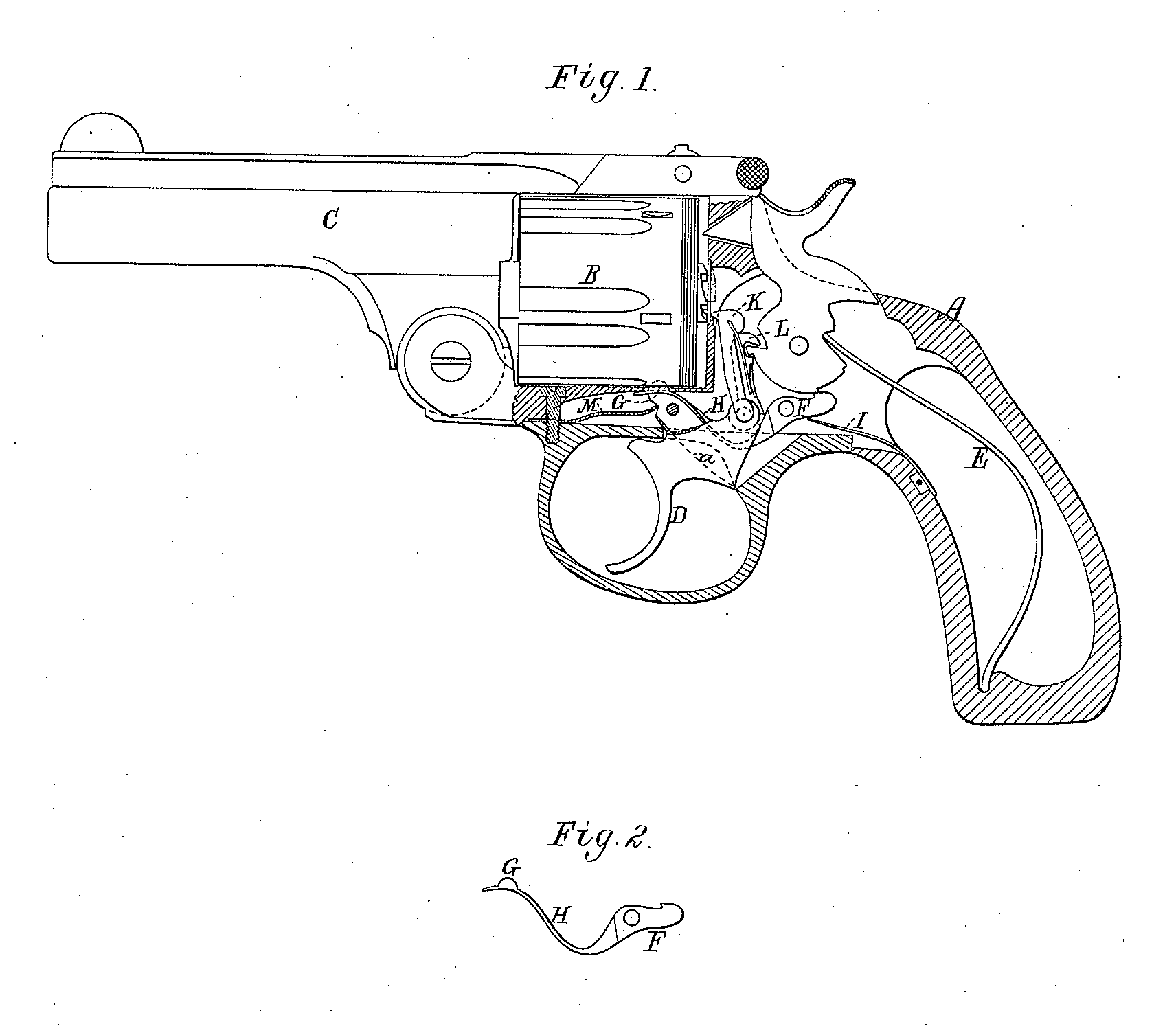US 304731
UNITED STATES PATENT OFFICE.
ARTHUR FRANCIS HOOD, OF BOSTON, MASSACHUSETTS, ASSIGNOR, BY MESNE ASSIGNMENTS, TO HIMSELF AND FREEMAN W. HOOD, OF SAME PLACE.
REVOLVER.
SPECIFICATION forming part of Letters Patent No. 304,731, dated September 9, 1884.
Application filed May 12, 1884. (No model.)
To all, whom, it in may concern:
Be it known that I, Arthur Francis Hood, of Boston, in the county of Suffolk, of the Commonwealth of Massachusetts, have invented a new and useful Improvement in Fire-Arms, termed “Revolvers;” and I do hereby declare the same to be described in the following specification and represented in the accompanying drawings, of which—
Figure 1 is a view, partly in section, of a pistol or revolver provided with my invention, the nature of which is defined in the claim hereinafter presented. Fig. 2 is a side view of the combined sear and cylinder bolt or latch to be described.
The revolver to which my improvement appertains is of the class usually termed “double action revolvers,” for the reason that the hammer of its lock can be raised to full-cock by the thumb of a person applied directly to it, or by the index-finger to the trigger.
In carrying out my improvement, the sear or catch of the hammer and the bolt of the rotary magazine or cylinder, as generally termed, are united by a spring rigidly secured to one or both. In raising the hammer to half-cock, the sear, in moving into engagement with the half-cock catch of the hammer, will move the said spring, so as to cause the bolt to be depressed out of engagement with the cylinder, in order to enable the cylinder to be revolved for being charged. In moving the hammer to full-cock, the seal will be depressed and will move the spring, so as to cause it to force the bolt upward into engagement with the cylinder, the latter in the meantime being revolved so as to carry one of its bolting-notches directly over the bolt, in order for the bolt to enter it. Before the sear comes into engagement with the full-cock catch of the hammer, such sear is acted on by the hammer in a manner to force the spring upward, and thereby cause the bolt to be moved against the cylinder, the spring having imparted to it sufficient power to throw the bolt into the bolting-notch of the cylinder on the hammer coming to full-cock. Were it not for the spring, or were the connection between the bolt and the sear a rigid arm, such arm would be bent in the act of bringing the hammer to full-cock, and would have no power to force the bolt into engagement with the cylinder.
In the drawings, A denotes the stock; B, the cylinder; C, the barrel; D, the trigger; E, the mainspring; F, the sear; G, the cylinder-locking bolt; H, the spring connecting the said bolt and sear; I, the sear-spring; K, the operative pawl of the cylinder, and L that by which the hammer is forced upward by the trigger, and the latter raised by the hammer, the said pawls K and L being pivoted to the trigger. When the hammer is at full-cock and the trigger is pulled to discharge the hammer, such trigger is borne against the sear at the junction of the latter with the spring extending from it to the bolt.
The usual spring for advancing the trigger after a retraction of it is shown at M. The spring H extends through the upper part of the trigger, which is grooved lengthwise to receive the spring, the bottom of the groove being exhibited by the dotted lines a.
In Fig. 1 the spring, where going through the trigger, is represented in dotted lines.
I claim—
In a revolver, the combination of the sear and the rotary cylinder-stopping bolt, with a spring or elastic arm, as represented, extending from one to the other, and connected to or in one piece with them, all being substantially as set forth, and to cause the bolt to be operated, as explained, by the sear during a retraction of the hammer, either to half-cock or to full-cock, as specified.
ARTHUR FRANCIS HOOD.
Witnesses:
R. H. Eddy,
E. B. Pratt.

